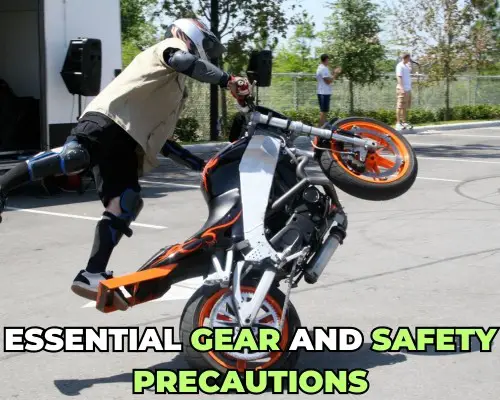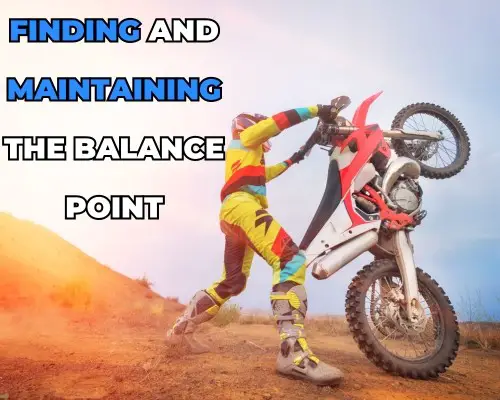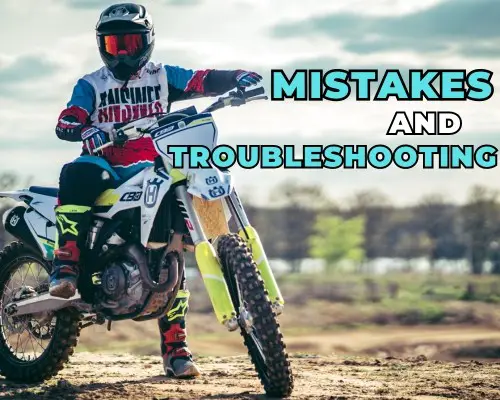Wheelies seem thrilling but intimidating, right? Many riders think mastering the wheelie is a rite of passage. It’s a mix of skill, balance, and raw courage.
But it’s not just about looking cool. Learning controlled wheelies can enhance your control and riding skills. Are you often frustrated with failed attempts and the complexity of tutorials?
Or maybe scared of flipping backward? These fears are valid. By breaking down the process into simple, manageable steps, you can start pulling off impressive wheelies safely.
Whether you’re a seasoned rider or a beginner, knowing the right techniques matters.
5 BEST Wheelie Techniques for YOUR Motorcycle

Clutch Up Technique
The clutch-up method is a foundational skill in wheelie execution, not just a fancy trick. Start by engaging second gear; it’s less jerky and more forgiving than the first.
Gently clutch in, give it some gas, then snap the clutch release. This quick action is what sends your front wheel skyward. Initially, aim for modest heights—just a few inches off the ground.
This builds your confidence and ensures control remains in your hands. Mastering this can take weeks, so don’t rush the process. Gradually, you’ll feel the bike’s response and adjust instinctively.
Throttle Control
Throttle control is more art than science. It’s what sustains your wheelie and keeps you balanced. Once airborne, fine-tune the throttle to find that sweet balance point where the bike feels almost weightless beneath you.
Remember, overzealous throttling can flip your bike backward—a common rookie error. Practice holding a steady throttle position to keep the wheelie stable and smooth.
According to experienced riders, maintaining a consistent engine rpm is crucial for prolonged wheelies.
Using the Rear Brake
The rear brake is your safety net. It’s essential for bringing your wheelie down safely, should you tip too far back.
Get into the habit of resting your foot on the brake pedal the moment your front wheel lifts. A slight press can save you from a backward tumble, which accounts for the majority of wheelie-related accidents.
Regular drills that combine throttle bursts with brake taps can dramatically improve your reaction time and safety.
Achieving the Balance Point
The balance point in a wheelie is akin to finding the perfect tempo in music—it’s exhilarating when hit right.
This elusive spot is where your bike stabilizes horizontally in mid-air. Achieving this requires gradual increments in your wheelie’s height, using careful throttle adjustments.
Don’t be discouraged if it takes time to find; even seasoned riders work continually to refine their feel for this balance. Use visual markers on your route to gauge and adjust your performance consistently.
Practice and Patience
As with any high-skill endeavor, perfecting wheelies is about consistent, patient practice. Begin with the basics and accept that small, incremental progress is still progress.
Always gear up with appropriate safety wear: helmets, gloves, and protective jackets are non-negotiable.
Remember, the best riders are those who respect the learning curve and put in the hours. According to a survey by a major motorcycle magazine, riders who practice wheelies regularly develop sharper overall riding reflexes.
Essential Gear For Wheelie and Safety Precautions

Getting into wheelies feels like stepping into a thrilling chapter of your biking life. But the excitement should never compromise safety.
Here’s a deeper dive into the critical gear and practices that keep you protected while you’re popping that front wheel up.
Recommended Protective Gear When Attempting Wheelies
Full Protective Ensemble:
- Helmet: Go for the full-face helmet. It’s your best bet against head injuries. The thrill of a wheelie is high, and so should be your level of protection.
- Gloves: Choose gloves with reinforced palms and knuckle protection. They should provide a firm grip and resist abrasion because controlling your bike starts here.
- Protective Clothing: Jackets and pants should be more than just fabric. Look for gear with integrated armor pads at critical points like elbows, back, and knees. Leather or high-performance textiles are your allies.
- Boots: Ankle injuries are common in falls. Durable boots that offer rigidity and flexibility where needed can be a game-changer.
- Butt Pad: Especially when you’re learning, sitting down hard on the pavement isn’t just painful; it can be injurious. A butt pad adds a layer of shock absorption.
Safety Measures to Prevent Injuries During Practice
Optimal Practice Environment:
- Choosing Your Ground: Grass fields are your best friends when starting. They forgive mistakes, unlike gravel or pavement, which are less merciful and can escalate injuries.
Essential Bike Modifications:
- Tip-Over Sensor Deactivation: It might sound like a minor tweak, but it’s a must if you don’t want your bike cutting out mid-wheelie. This is particularly crucial for fuel-injected bikes.
- Steering Damper Functionality: When you bring that wheel down, you want it smooth, not slapping. A functional steering damper can prevent a wobble-turned-crash, known among riders as a tank slapper.
- 12 Bar Installation: Planning to push limits with “12 o’clock” wheelies? A 12 bar isn’t just recommended; it’s essential. It protects your bike’s back end from kissing the ground.
Protective Gear Use:
- All-Around Protection: Every ride, every time. Helmet, armored jacket, jeans, gloves. No compromises. The road doesn’t care how skilled you are.
Mechanical Preparations:
- Rear Brake Readiness: It’s your main control tool once up in the air. Adjust the lever within easy reach and ensure it responds promptly.
- Chain and Peg Integrity: A loose chain or cracked pegs can turn a practice session into a nightmare. Regular checks are mandatory.
Practice Considerations:
- Secluded Area Use: Find a spot away from public eyes and traffic. Legal issues aside, you need space to learn without risks to others.
- Skill Building: Like mastering any art, wheelies take time. Rushed attempts can lead to more than just bruised egos; they can cause real harm.
By going beyond just donning gear and adjusting a few bike settings, these practices embed safety into the very culture of wheelie training.
Like that time, I underestimated my duffle’s weight and broke the scale—overconfidence in your prep can lead to unexpected outcomes.
Equip well, prepare thoroughly, and ride into that wheelie with expertise and caution lighting your way.
Finding and Maintaining the Balance Point When Performing a Wheelie

Nailing the balance point in a wheelie is like walking a tightrope; it’s thrilling yet demands precision and poise.
Every motorcycle has its quirks, and every rider their style, but finding that perfect balance is universally challenging.
Let’s enhance our understanding with deeper insights and hands-on advice to master this delicate balancing act.
Tips on Discovering the Balance Point for Different Motorcycle Models
Understanding the Balance Point:
- The balance point is that moment where your bike balances precisely on its rear wheel, with the front lofted gracefully. It feels as though the bike is hovering, a moment of pure equilibrium.
Model-Specific Practices:
- Bike Characteristics: Lighter bikes with lower centers of gravity are more forgiving for beginners. Each model responds differently, so it’s essential to get a feel for how your specific bike behaves.
- Uphill Advantage: Practicing on a slight incline can dramatically ease the challenge. The incline naturally helps sustain the front lift, reducing the initial effort required to find the balance point.
- Stand-up Techniques: For better leverage and control, try stand-up wheelies. Positioning both feet on the back pegs shifts your weight directly over the rear, stabilizing the bike vertically.
Progressive Learning:
- Clutch Wheelies: Mastering the clutch wheelie involves delicate throttle control – too much and you flip, too little and the front wheel descends. Start with small, controlled bursts.
- Feedback and Adjustment: Every practice run tells you something. Listen to the feedback your bike gives and adjust your technique accordingly. It might take several sessions to start feeling the balance, but each attempt is progress.
Exercises to Practice Maintaining Balance During a Wheelie
Line Control:
- Practice Makes Perfect: Consistent practice in maintaining a straight line is crucial. Sudden shifts or jerks can destabilize the wheelie, potentially causing falls.
Duration and Control:
- Build Endurance: Start with short-duration wheelies and incrementally increase the time as you gain confidence. This builds both skill and muscle memory.
- Dynamic Weight Adjustment: Learn to subtly shift your weight back and forth. This active balancing helps manage the bike’s position dynamically, essential for long wheelies.
Brake Usage:
- Rear Brake Control: The rear brake isn’t just for emergencies; it’s a critical tool for fine-tuning your altitude during a wheelie. Gentle taps can bring you back from a too-high lift or stabilize a wobbly ascent.
Enhancing your practice with these tips isn’t just about doing something cool; it’s about becoming one with your bike, understanding its rhythm and reactions as if it were a part of your own body.
Like the time I packed my duffle, certain it was under the weight limit, only to discover at the most inopportune time that I had miscalculated—it’s easy to think you’ve got it all figured out, only to have real-life practice humble you.
Wheelies are a blend of art and science, adrenaline, and meticulous control, and with the right approach, you can master this captivating motorcycle maneuver.
Common Wheelie Mistakes and How to Fix Them

Wheelies, that exhilarating motorcycle trick, can quickly go from exciting to daunting for beginners. Much like that first time, I thought my duffle was light enough only to break the scale, early attempts at wheelies often reveal surprising challenges. Let’s delve deeper into the common mistakes beginners make and how to skillfully overcome them.
Identification of Frequent Errors Beginners Make When Learning Wheelies
Starting Technique:
- Static Starts: Beginners frequently start their wheelies from a complete stop, which can lead to a rigid body posture and delayed reactions.
- Solution: Always start while rolling slowly. This approach not only helps with momentum but also eases the bike into a smooth lift, enhancing control from the outset.
Overwhelming Steps:
- Simultaneous Actions: Attempting to manage the clutch, throttle, and balance simultaneously can overwhelm any rider, muddling the learning process.
- Solution: Decompose the wheelie into manageable stages. Perfect each stage individually, gradually combining them as you gain confidence and control.
Misconceptions About Lifting:
- Arm Strength Myth: A common beginner belief is that wheelies are all about upper body strength.
- Solution: Focus more on technique rather than force. Effective wheelies rely on a blend of clutch finesse, precise throttle control, and strategic body positioning—not just brute arm strength.
Personalization of Technique:
- Copycat Errors: Imitating another rider’s style may not yield success due to different body types, bike setups, and skill levels.
- Solution: Experiment with your setup. Adjust your bike’s gear and seating position. Tailor your approach based on your own physicality and the unique characteristics of your motorcycle.
Incorrect Settings:
- Equipment Setup: Inadequate bike preparation can sabotage your wheelie efforts before you even begin.
- Solution: Regularly fine-tune your bike. Ensure that the tire pressure is optimal, the brakes are responsive, and the chain is adequately tensioned. These adjustments can greatly influence your bike’s wheelie capability.
Solutions and Adjustments to Overcome These Challenges
Incremental Learning:
- Practice Gradually: Just like learning to pack a bag efficiently, mastering wheelies takes patience and practice. Focus on one element at a time, steadily advancing to the next as you improve.
- Regular Drills: Establish a consistent practice routine, concentrating on mastering each component of the wheelie independently before attempting to combine them.
Balance and Control:
- Patience in Practice: Finding that balance point where your bike feels as if it’s floating requires time and a gentle touch.
- Body Mechanics: Learn to gradually shift your weight backward, increasing your feel for the bike’s balance over time. It’s a subtle dance between rider and machine that needs to be harmonized perfectly.
Technical Adjustments:
- Check and Adjust Equipment: Routine mechanical checks are as crucial as any riding skill. A well-maintained bike responds better, making learning easier.
- Avoid Common Setup Mistakes: Like ensuring a vacuum isn’t clogged before cleaning, make sure your bike’s setup is conducive to performing wheelies. Proper tire pressure, brake functionality, and correct chain slack are pivotal.
By understanding and addressing these common mistakes with tailored solutions, you can elevate your wheelie skills from clumsy attempts to smooth, controlled maneuvers.
Each session is a learning curve—much like my experience with that overweight duffle bag, every mistake teaches you something vital about the art of wheelies.
As an Amazon Associate, I earn from qualifying purchases, at no additional cost to you. Read Our Affiliate Disclosure.

